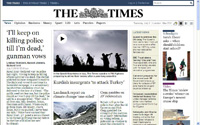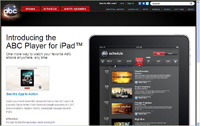 Readers can sign up for an exclusive preview of the new Times website.
Readers can sign up for an exclusive preview of the new Times website.
 ABC.com introduces the ABC player for iPad.
ABC.com introduces the ABC player for iPad.Traditionally, scholars tend to take “media use” as an indicator of popularity and diffusion. However, research on the use of and preference for online news suggested that usage does not always correspond to attitudinal factors driving the media selection process. Moreover, recent research by Chyi and Yang examining the economic nature of online news found that users perceive online news as an “inferior good”—a less appealing alternative compared with normal goods—which may explain the lack of paying intent and the negative attitude toward online news.
These lines of research suggest the importance of attitudinal factors in determining user response to online news. In a recent study entitled “Who Would Miss Getting News Online and Why (Not)? Examining Users’ Emotional Attachment to Online News, an Inferior Good,” we expanded such research on the perception of online news by examining users’ emotional attachment to online and traditional news media, analyzing recent data collected through a large-scale, random-sample survey in the United States. This article attempts to communicate the rationale and key findings of that study in everyday language.
Media Use vs Media Perception
Media use has long been a central concern in communication and journalism research. This tradition remains strong in new media research. In contrast, attitudinal factors (e.g., liking, media preference) related to media consumption have not received nearly as much scholarly attention as behavioral factors such as media use. One of the reasons for this emphasis on media use (as opposed to attitudinal factors) is that media goods in general were a scarce resource until recently. As Picard puts it, in the past, media consumption occurred “because audience had few choices to watch anything else at the time slot.” However, as the Internet emerged as a mass medium in the 1990s and because of the proliferation of content brought about by the Web 2.0 era, each user is presented with ever-increasing choices of media products—news and non-news, media- and user-generated content, through traditional as well as digital channels. In this media environment characterized by “information surplus” (Chyi, 2009), where numerous information outlets oversupply information to compete for user attention, users make choices among a mix of media products that are “imperfect substitutes” (Lacy, 2004). So media use now follows media selection, a process driven by user perception of various media goods. It is therefore essential not to take for granted the conventional approach that emphasizes media use over media perception, as the media environment has changed.
User Perception of Online News
Online news has been gaining in importance in terms of usage, but paying intent remains low and the reasons behind the discrepancy between usage and users’ willingness to pay have become more evident as relevant research cumulates. One principal reason is the fairly negative perception of online news—an attitudinal factor. Researchers examining user perception of online news found that the Web as a news medium appears to be less favorable than newspapers or television. For example, a 2008 survey conducted by the Online Publishers Association of 25,852 visitors to 41 major news sites found that online media were “less satisfying, less likeable, and less enjoyable” than offline media. A Hong Kong-based study measured general liking of different news media by asking Internet users to indicate how much they like online news, newspapers, TV news, and radio news; online news turned out to be the least likable news format. A survey of Dutch newspaper readers comparing the usefulness of online newspapers with print newspapers and other media in several content areas reported that respondents found print newspapers and television more useful than online newspapers in every domain. These studies, despite different measures and methodological approaches, have documented fairly consistently the negative attitude toward online news among users or potential users.
Emotional Attachment to News Media
Built upon previous research measuring perceived ease of use, preference, liking, and perceived usefulness, Chyi and Yang’s study seeks to examine another attitudinal factor—emotional attachment, which captures media perception in a reverse manner by asking respondents how much they would miss a particular news medium if it were no longer available. This measure has become increasingly popular in surveys because of declining circulation and viewership of traditional media.
Utilizing empirical data from the Biennial Media Consumption Survey conducted by the Pew Research Center for the People and the Press from April 30 to June 1, 2008, Chyi and Yang investigated the extent to which users are emotionally attached to online news, newspapers, and network TV news. Table 1 presents the results.
Among regular online news users (those who went online for news at least once a week), 23 percent said they would not miss getting news online much or at all; 24 percent would miss it somewhat; 53 percent said they would miss it a lot.
To make cross-media comparison, the mean score of emotional attachment was calculated for each of the three news media. According to Table 1, network TV evening news got the highest score (3.53), followed by newspapers (3.33), and online news (3.21). Repeated measures ANOVA analysis compared the mean scores among the same individuals who responded to all three questions. Similarly, network TV evening news got the highest score (3.61), followed by newspapers (3.36), and online news (3.20). The difference in emotional attachment scores for the three news media is statistically significant (p<.001). So, consistent with past research on user perceptions of news media, the findings indicated that TV news still is the most favorable news medium in terms of emotional attachment among regular users.
The study also looked into the factors driving emotional attachment to online and traditional news media. News interest is a common positive predictor of emotional attachments across all media, but demographic variables have very different influences on emotional attachment to traditional vs. online news media.
Take gender as the first example. Results of the regression analyses indicated that being female is associated with higher emotional attachment to print newspapers and network TV news but lower attachment to online news. In other words, gender distinguishes attachment to traditional vs. online news media—men are more likely to miss getting news online, while women tend to be traditionalists. As decades of research on media use has documented a gender gap of news consumption, indicating that men are usually more likely to be users of both traditional and online news media, this study demonstrated counter-intuitive findings, revealing that, when it comes to emotional attachment, being male actually has a negative influence on emotional attachment to newspapers and TV news.
Beyond gender, age is another factor differentiating emotional attachment to online vs. traditional news media. Age is found to be a negative predictor of attachment to online news but a positive predictor for attachment to newspapers and TV news. The fact that younger users, compared with older users, are more likely to be emotionally attached to online news but less so to traditional news media may be explained by the fact that younger adults grew up with computers in their households with Internet connections. As a result, their emotional attachment to online news could be part of their overall reliance on the computer and the Internet in general.
Income and educational level also distinguish emotional attachment to online vs. traditional news media. While education positively predicts attachment to online news, it has a negative impact on attachment to TV news, suggesting that online news and network TV news are “intellectually” different. Other than education, household income also is a positive predictor of emotional attachment to online news.
These findings illustrate the discrepancy of emotional attachment to online and traditional media. In other words, the distinction between traditional and new media is defined not only by technology but also by user perception and different sets of factors underlying that perception.
Implication
Overall, the researchers suggest that, despite continued growth in usage, online news users still do not favor online news specifically. The level of emotional attachment to online news is no higher than that to traditional media that are suffering from audience decline. So, usage of a particular news medium does not necessarily translate to preference for that medium.
For publishers who are striving to profit from their online content in the multiplatform media landscape, understanding both usage and perceptions of online news helps develop content and pricing strategies as they seek to monetize news on emerging platforms such as smartphones, e-readers, and the iPad.
■Hsiang Iris Chyi, Ph.D.
Assistant Professor, School of Journalism
The University of Texas at Austin


